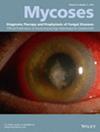比较银屑病患者和非银屑病患者趾甲甲癣的皮肤镜特征:前瞻性研究
IF 4.1
2区 医学
Q1 DERMATOLOGY
引用次数: 0
摘要
背景银屑病患者可能同时患有甲癣(OM)。患者和方法在 2020 年 9 月至 2023 年 9 月期间,在两个中心对 183 例银屑病患者受 OM 影响的脚趾甲和 232 例非银屑病患者受 OM 影响的脚趾甲进行了皮肤镜检查。结果在银屑病患者的趾甲OM病例中,最常见的皮肤镜特征包括点状(147/183,80.33%)和甲下角化过度(118/183,64.48%)。与此相反,非肢体瘫痪患者的脚趾甲 OM 的特征是甲下角化过度(175/232,75.43%)和甲尖(139/232,59.91%)。比较分析表明,点状甲(80.33% vs. 15.96%,p < .001)、甲周毛细血管扩张(22.40% vs. 4.74%,p < .001)、油斑(12.57% vs. 0.43%,p < .001)和横沟(43.72% vs. 28.45%,p < .01)在银屑病患者脚趾甲 OM 中的发生率明显更高。此外,精神病患者的脚趾甲 OM 表现出黄色无结构区(13.11% vs. 42.67%,p < .001)、甲尖(43.17% vs. 59.91%,p < .01)、硫块废墟外观(8.20% vs. 31.结论银屑病患者和非银屑病患者趾甲 OM 的皮肤镜特征表现出显著差异。银屑病患者的甲沟炎表现为点状出血和甲周毛细血管扩张的频率较高,而在皮肤镜下表现为黄色无结构区和甲尖的频率较低。本文章由计算机程序翻译,如有差异,请以英文原文为准。
Comparison of dermoscopic characteristics on toenail onychomycosis in psoriatic and non‐psoriatic patients: A prospective study
BackgroundPsoriatic patients may experience the coexistence of onychomycosis (OM). However, the evaluation of OM in psoriatics has been hindered by potential clinical differences from OM in non‐psoriatics.ObjectiveTo assess and compare dermoscopic features between toenail OM in psoriatic and in non‐psoriatic patients.Patients and MethodsBetween September 2020 and September 2023, dermoscopy was conducted on 183 affected toenails by OM in psoriatics and 232 affected toenails by OM in non‐psoriatics in two centres. The dermoscopic characteristics were compared using the Chi‐squared test.ResultsAmong toenail OM cases in psoriatic subjects, the most prevalent dermoscopic features included pitting (147/183, 80.33%) and subungual hyperkeratosis (118/183, 64.48%). Conversely, toenail OM in non‐psoriatics was characterized by subungual hyperkeratosis (175/232, 75.43%) and nail spikes (139/232, 59.91%). Comparative analysis revealed a significantly higher occurrence of pitting (80.33% vs. 15.96%, p < .001), periungual telangiectasis (22.40% vs. 4.74%, p < .001), oil patches (12.57% vs. 0.43%,p < .001) and transverse grooves (43.72% vs. 28.45%,p < .01) in toenail OM in psoriatics. Furthermore, toenail OM in psoriatics exhibited a significantly lower frequency of yellow structureless area (13.11% vs. 42.67%, p < .001), nail spikes (43.17% vs. 59.91%, p < .01), ruin appearance of sulphur nugget (8.20% vs. 31.03%, p < .001), dotted/blocky haemorrhage (6.01% vs. 20.69%,p < .001) and partial onycholysis (32.79% vs. 46.98%, p < .01).ConclusionsDermoscopic features of toenail OM in psoriatic and non‐psoriatic patients exhibit notable differences. OM in psoriatics shows a higher frequency of pitting and periungual telangiectasis, while a lower frequency of yellow structureless areas and nail spikes under dermoscopy.
求助全文
通过发布文献求助,成功后即可免费获取论文全文。
去求助
来源期刊

Mycoses
医学-皮肤病学
CiteScore
10.00
自引率
8.20%
发文量
143
审稿时长
6-12 weeks
期刊介绍:
The journal Mycoses provides an international forum for original papers in English on the pathogenesis, diagnosis, therapy, prophylaxis, and epidemiology of fungal infectious diseases in humans as well as on the biology of pathogenic fungi.
Medical mycology as part of medical microbiology is advancing rapidly. Effective therapeutic strategies are already available in chemotherapy and are being further developed. Their application requires reliable laboratory diagnostic techniques, which, in turn, result from mycological basic research. Opportunistic mycoses vary greatly in their clinical and pathological symptoms, because the underlying disease of a patient at risk decisively determines their symptomatology and progress. The journal Mycoses is therefore of interest to scientists in fundamental mycological research, mycological laboratory diagnosticians and clinicians interested in fungal infections.
 求助内容:
求助内容: 应助结果提醒方式:
应助结果提醒方式:


